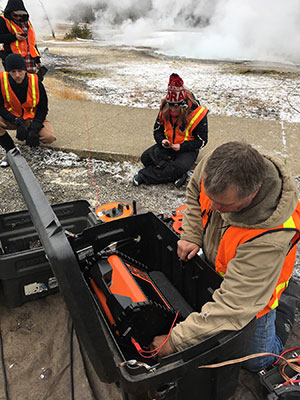UW’s Carr Leads Geophysical Imaging of Yellowstone’s Spouter Geyser
Published March 10, 2023

A University of Wyoming researcher led a five-year study that imaged the actual structure -- at a level of detail not previously accomplished -- of Spouter Geyser in Yellowstone National Park.
“This is the first study to actually generate images of the features; tie those images to the physical material properties of the units hosting the geysers; and observe the dynamic behavior of geysers in the subsurface versus simply on the surface,” says Brad Carr, an associate research scientist in the UW Department of Geology and Geophysics.
Carr was the corresponding and second author of a paper titled “Geophysical Imaging of the Shallow Geyser and Hydrothermal Reservoir Structures of Spouter Geyser, Yellowstone National Park: Geyser Dynamics I” that appeared Feb. 3 in the Journal of Geophysical Research Solid Earth, which publishes papers in a broad range of earth science disciplines.
Ken Sims, a UW professor of geology and geophysics, and Daniel Ciraula, a UW master’s student of geology and geophysics under Carr from 2019-2021, contributed to the paper. Ciruala, the paper’s lead author, is now a Ph.D. student conducting geothermal energy geophysics research at the University of Iceland in Reykjavik, Iceland.
Yellowstone National Park is home to about 500 geysers, which makes it the most concentrated geyser field in the world, according to the paper. Although Spouter Geyser is considered a fountain, or pool geyser, it is located about a mile away from Old Faithful, and its subsurface geology is the same as the park’s most famous geyser.
“So, by understanding how Spouter Geyser looks and operates, we get greater understanding of Old Faithful by default. Second, we show how near-surface geophysical methods can observe the dynamic behavior of geysers in real time,” Carr says. “These efforts don’t need to wait for earthquakes or bubble bursts to make arguments about the dynamic behavior of geysers.”
The study, which took place from 2017-2021, represents research results taken from active hydrogeophysical surveys -- including ground-penetrating radar, nuclear magnetic resonance, seismic refraction, electrical resistivity tomography and transient electromagnetics -- to image the subsurface geyser structure and constrain the geophysical response of the reservoir structure of Spouter Geyser.
Data acquisition was only allowed during a week or two in November and a week or two in April. These are the only short periods available for study when the park is closed to tourists, Carr says.
Previous studies relied on conceptual cartoons to understand the geyser structure and dynamics, Carr says. Over the last 20 years, geophysical efforts increased to try to gain more understanding, but few ever committed multiple geophysical methods to actually image these features on-site, he adds.
“We were the first, and I intend to continue this effort at other types of modern geysers,” Carr says. “To start, we are finishing a manuscript on similar efforts at Old Faithful and hope to get this paper published within the year.”
Carr and his research team found that, when Spouter Geyser erupts, it only loses 2 percent to 3 percent of the total water available within its geyser reservoir structure. On average, Spouter Geyser ejects 18,990 gallons of hydrothermal water during a 1.5-hour eruption. If that is only 2 percent to 3 percent of the amount of hydrothermal water in the geyser reservoir, the total amount of hydrothermal water is 949,500 gallons, he says.
To put this into context, Carr says an Olympic-size swimming pool is 50 meters in length, 25 meters in width and has a minimum depth of 2 meters, allowing the pool to hold 660,430 gallons when filled to the top. Additionally, for comparison, the average tanker truck driving on Interstate 80 holds about 11,000 gallons of liquid.
“Therefore, the subsurface geyser reservoir structure for Spouter Geyser holds 1.5 Olympic swimming pools’ worth of hydrothermal water and ejects about two tanker trucks’ worth of hydrothermal fluids over 1.5 hours,” Carr says.
According to the paper, the knowledge of subsurface geyser structure and geyser eruption dynamics can be applied to other processes, including hydrothermal explosions and volcanic eruption dynamics, in Yellowstone National Park.
“These methods could be applied to other geysers to understand better the differences in geyser eruption behavior,” he says. “Additionally, our findings show potential for using time-lapse electrical resistivity measurements as a monitoring tool for the hydrothermal explosion hazards within Yellowstone National Park and the sustainable development of geothermal reservoirs globally.”
The work was funded by grants from UW’s Near-Surface Geophysics Instrument Center, the UW Foundation and a UW Faculty Grant in Aid.
A companion paper titled “Time-Lapse Geophysical Investigation of Geyser Dynamics at Spouter Geyser, Yellowstone National Park: Geyser Dynamics II” was published Feb. 5 in the same journal.
“It was necessary to establish the geyser structure within the glacial till of Upper Geyser Basin first, since no one had ever done this detailed level of geophysical imaging at a geyser before,” Carr explains. “After establishing the geyser structure, the second paper discusses how we used geophysical methods to monitor the dynamics of Spouter Geyser.”
The dynamics of the geyser involve the fluid and vapor phase (steam and gases) interactions within the geyser reservoir structure. Additionally, the research team looked at the outflow fluid temperature data over the past 23 years to show how the eruption times of Spouter Geyser are staying nearly constant at 1.5 hours. However, the recharge times -- the times when Spouter isn’t erupting -- are shortening at a rate of 6.6 minutes per year, Carr says.
This work was conducted under YSNP Geophysical Research Permit YELL-6090 (Sims).

